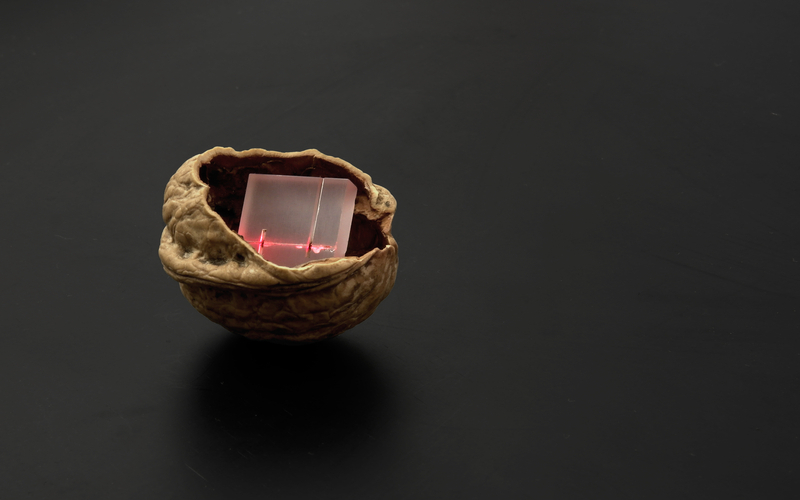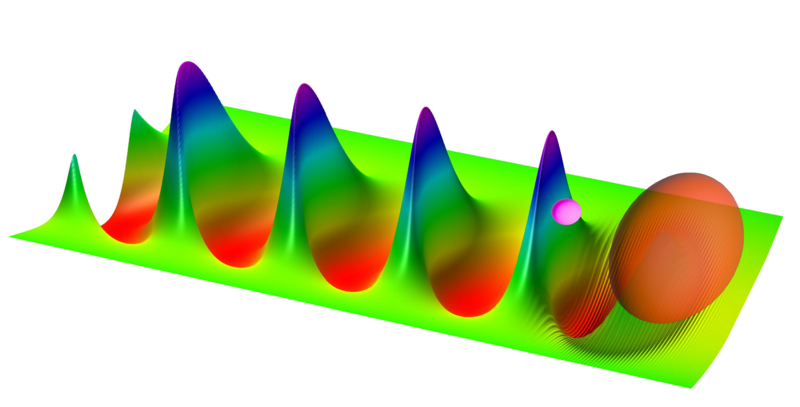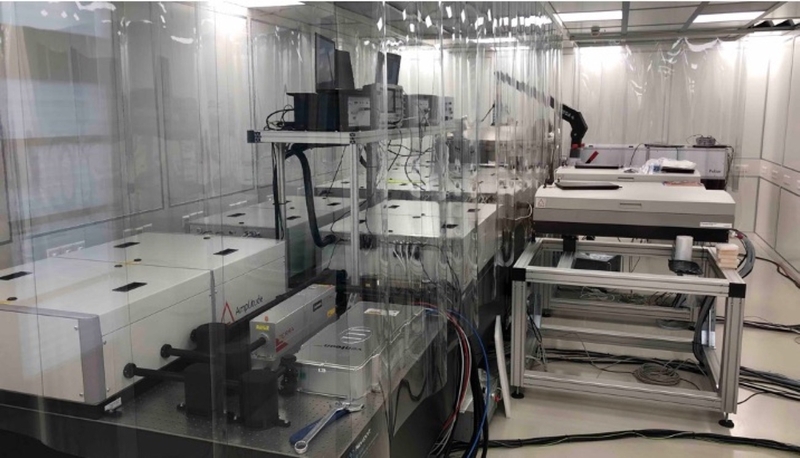Compact Accelerators
Laser-Plasma Accelerators
Accelerator in a nutshell by surfing plasma waves

The accelerator structure of novel laser-plasma accelerators generating near 1 GeV beams can readily fit into a standard nutshell.
Photo credit: Thorben Seggebrock.
We develop a novel method of compact electron acceleration based on laser-plasma interactions. Compared to conventional radiofrequency (RF) technology, our approach enables a reduction in accelerator size by 3 to 4 orders of magnitude - from the kilometer to the centimeter scale. The compact dimensions of the accelerators also greatly reduce the cost and make the operation more sustainable due to increased energy efficiency, simply by a major reduction in infrastructure dimensions. Persistent efforts have led to the demonstration of ultrashort, high-quality electron beams with energies of few hundred megaelectronvolts (MeV) to few gigaelectronvolts (GeV). In these so-called laser-wakefield accelerators (LWFAs), an ultrashort high-power laser is focused into a gas target, where it ionizes the atoms and generates a plasma. As the laser travels through the plasma, it is trailed by a wave in its wake, just like a boat on a calm lake. In the LWFA case, however, the wave consists of electrons and not of water molecules and the laser is moving at almost speed of light. Electrons can be injected into the wave and similar to a surfer at the beach, these electrons get accelerated by "surfing" the wave. Since the accelerating field associated with the plasma wave is so immense (and traveling at almost speed of light), the injected electrons get rapidly propelled to relativistic energies - over a distance of only a few millimeters to centimeters.

Artistic representation of the LPA process. An ultrashort laser pulse (red) moving to the right excites a plasma wave.
An electron bunch (pink) gains energy by “surfing” the plasma wave. Image credit: Brad Shadwick.
The accelerated electron bunch is ejected from the plasma into a well-collimated narrow forward beam with parameters comparable to (and in some regards even better than) those of conventional accelerators. Moreover, the duration of the electron pulse of LWFAs is of an intrinsically ultrashort timescale which has recently been experimentally verified to be approximately 3 fs (1 fs = 10-15 s). The compact size and versatility of LPAs makes them interesting candidates for many applications, ranging from fundamental research and compact X-ray sources to societal and medical applications.
Future research directions at KIT
At KIT, we are currently in the process of commissioning a brand-new high-power driver laser system and setting up an LPA test facility.

The brand-new 75 TW high-power laser system at KIT in commissioning.
Development of stable LPAs as an injector for the cSTART electron storage ring

AI-generated artistic representation of what a future LPA could look like.
The use of LPAs for applications requires stable and reliable operation. LPAs are moving from proof-of-concept experiments to reproducible accelerators. This allows us to consider first applications of LPAs. In particular, at KIT we are developing novel LPAs with the goal to use as injector into an electron storage ring, specifically the cSTART research accelerator. cSTART is specifically designed to accommodate the comparably large energy spread of LPA electron bunches and to investigate the dynamics of ultrashort electron bunches in non-equilibrium. The LPA that we will develop for this project will have to reproducibly generate electron bunches with a high stability and with parameters that can be accepted by cSTART. To this end, we will investigate injection mechanisms of electrons into the accelerating plasma wave and the phase-space dynamics during acceleration to generate electron bunches with small energy spread, ideally below 1% that are tunable over a wide parameter range, including charge and beam energy.
Compact laser-driven light sources

LPAs can be operated in a mode, where the electron perform large-amplitude transverse so-called betatron oscillations during the acceleration. These oscillations lead to emission of highly brilliant X-ray radiation. The figure shows a simulation with a laser (not visible) propagating to the right that drives a “bubble” plasma accelerating structure. Electrons inside this bubble perform large scale transverse oscillations. The electrons are color-coded by total energy (left) and transverse momentum (right).
Relativistic electron beams can be used to generate ultrashort, high brilliance X-ray pulses. We are developing what might be termed a next generation light source: a brilliant, compact X-ray source with the potential for widespread application in university-scale laboratories. In these sources, relativistic electron bunches are transversally accelerated, leading to the emission of synchrotron radiation. This acceleration is typically caused by magnetic structures, called undulators, or by electro-magnetic fields, such as lasers or the accelerating plasma structure in an LPA. We are developing methods for laser-driven compact light sources and investigate methods to improve their properties.

LPAs can be used to drive compact light sources. An LPA-generated electron beam is guided by electron beam optics through a magnetic structure, called undulator, where radiation is generated. Subsequently, the electron beam properties are characterized and the generated light can be analyzed or used for applications.
Next-generation laser-plasma accelerators
We are also investigating new plasma-based method of electron acceleration that can lead to even more compact accelerators with higher field gradients, a higher energy efficiency than LWFAs and that can use a wider range of laser technologies as driver. This project includes research of fundamental laser-plasma interactions, investigation and optimization of the accelerated electron bunches and the development of novel technology to further improve the electron beam properties. It also includes first applications of the generated electron bunches.
